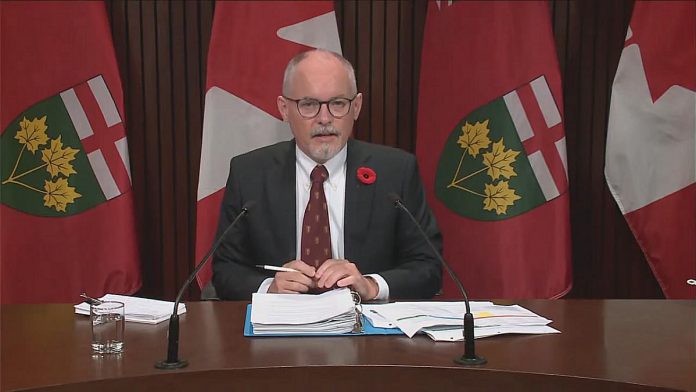
With new COVID-19 cases trending higher again in Ontario, the provincial government has put the brakes on lifting capacity limits on night clubs, strip clubs, and similar settings.
Ontario’s chief medical officer of health Dr. Kieran Moore made the announcement during a media briefing on Wednesday afternoon (November 10). However, he also expressed optimism the pandemic remains under control in Ontario.
“Out of an abundance of caution, we are pausing the next step of the plan to reopen Ontario and manage COVID-19 for the long term,” Dr. Moore said. “This means that the planned lifting of capacity limits in remaining settings where proof of vaccination is required will not be moving ahead on November 15.”
These settings include food or drink establishments with dance facilities, such as nightclubs and wedding receptions in meeting/event spaces where there is dancing, strip clubs, and sex clubs and bathhouses.
The pause — which will remain in place until December 15 when the province will reevaluate the decision — comes after Ontario has seen an increase in some of its key indicators over the past two weeks, including the effective reproductive number, the percentage of positive tests, and weekly case rates.
On Thursday, the provincial government reported 642 new cases, the highest increase in daily cases since October 9 when 654 new cases were reported. Some regions of the province, such as Sudbury, Simcoe Muskoka, and Windsor-Essex, have recently seen rapid double-digit case increases.
Dr. Moore said the province was always anticipating an increase in cases with the easing of restrictions and as more people move indoors due to the colder weather.
“It’s spreading mostly from the 20 to 39 year old age group, it’s mostly in social settings where we take off our masks, where we have close contact as we move indoors in closed spaces, and that’s where most of the transmission is occurring,” he said.
Dr. Moore pointed out that the rate of transmission in schools, especially secondary schools, remains low due to increased vaccinations among the 12 to 17 year old age group.
“As we go forward to have vaccinations for five to 11 year olds, I think our elementary schools will even be further protected,” he added.
After the province revisits the pause on lifting capacity limits on December 15, the next major decision date will be on January 17, when the government will decide whether to lift vaccine certificate requirements for restaurants and bars, sports and recreational fitness facilities, waterparks, and casinos and bingo halls.
“The plan will continue to be, in the second week of January, to reassess the data that will reflect the holiday season, the return to school, colleges, and universities, and at the time make any further determination on further removal of public health measures,” Dr. Moore said. “It will be driven by the data and the analysis.”
Despite the recent increase in cases, Dr. Moore remains optimistic, citing the province’s capacity for lab testing and public health follow-up, the coming vaccine for five to 11 year olds, new antiviral medications, and the fact Ontarians are still adhering to public health practices.
“I have to thank Ontarians for continuing to remain vigilant, continuing to come forward to get vaccinated and now, with our third doses, we’ll even be better protected,” he said. “Some people will look at the cup and say it’s half empty, I’m saying it’s half full — that we have systems in place to best protect Ontarians going forward, that caution and vigilance is required, but we’re in a much better place than we’ve even been before, with new tools at our disposal very soon.”
Dr. Moore also assured Ontarians the province as a whole will not be “stepping backwards” because of recent increases, but will instead take additional public measures with individual health units as required.
When asked by a reporter what new developments would give him cause for alarm, Dr. Moore referred to two “major gamechangers” that could threaten the province’s strategy.
“An influx of returning travellers with high positivity and/or a new strain that the vaccine doesn’t prevent against always keeps me up at night,” he said, adding that international surveillance, some testing of returning travellers, and genome sequencing of positive results from returning travellers would be needed.


























